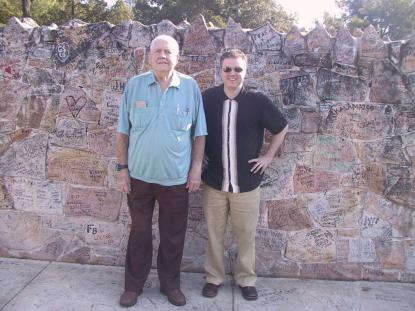Ira Glass always sounds as if he’s got a bag of Cheetos just off-mic for between-sentence scarfing. At least, in my world of radio magic, that accounts for his strange, halting delivery. But Glass is up to something that’s bordering on real brilliance with This American Life. Something that can’t be undermined even by the machinations of Frito-Lay.
His is a quietly subversive job. As media saturation becomes commonplace, what could be more absurd than inhabiting a medium without so much as a picture? I think it’s the intimacy of radio that keeps it alive. I used to listen to This American Life in the dark, feet up, downing mind-rattling espresso. The glow of a lava lamp seemed necessary. You get comfortable with radio in a different way than television. You can stare at the spider web in the corner you should have swept away months ago while Glass sputters. Your mind can wander without being drawn to the flicker of a screen and into the dread soporific of its tunnel-vision luminescence.
When I had the pleasure of interviewing Glass last fall, I felt as if I was being informed by the magician just exactly how the tiger disappears. (Fortunately, I’m relieved to note, the tiger still astonishes.) Radio’s particular glories aside, Ira Glass’ show taps into something primal. At the most basic level, Glass is a crafter of story, and nothing mesmerizes us primate revelers like a good story. He gets that. And, as he notes, slathering on vast amounts of music like marmalade on toast never seems to reach a point of being overdone.
Contrast that with what happens (okay, at least to me) when I see something in a film that’s too dressed up with music—it becomes instant Velveeta. And, as Glass demonstrated at his recent Calvin appearance, the power of music suddenly going away has substantial impact—whatever is said just then becomes “really, really important.”
It’s also helpful to know that this magic is not worked without effort—Glass said that, to get those three stories that really work, his staff might work on 10 or 12 any given week. In any case—when This American Life works, it really, really works. The stories are good stories regardless of their American-ness or lack of, but there is a certain wistful, "Home on the Range" quality that creeps in.
I’ve been pondering what that gorgeous wistfulness is, and how to work some of that kind of magic myself, because I’ve undertaken a sort of related project that has so far spanned years. I’ve known a man named Harris Mills since I was a boy and my father, then a full-time Baptist preacher, met Harris when he went to Horn Lake, Mississippi to preach a revival. Our familes became good friends, and knowing Harris was (and is) a grand thing for a young guy who’d known neither of his grandfathers.

Harris Mills (left) and the author at Graceland
Harris Mills is an extraordinary storyteller. His cadences are enormously Southern, and his rapid-fire, wide-eyed delivery—he’s an imposing figure, even in his 80s—is by turns visceral, gripping and hilarious. There is much to be said for the preservation of American stories such as his for the most obvious of reasons: he was a gunnery sergeant in the Pacific during World War II, present at two of the bloodiest battles in our history, Guadalcanal and Peleliu (so bloody and caualty-ridden it wasn't widely discussed until well after the war). But as a musician I undertook, at the brilliant suggestion of the bassist I was then collaborating with, putting Harris’ stories to music instead of just dropping the proverbial jaw.
Why I felt the need to do this I’m not entirely sure. It just seemed the proper move, on one level. But more than that, there is something about grand storytelling that invites participation. Obviously, I couldn’t tell a story to match Harris’ tale of trying to outrun a Japanese Zero on the runway at Guadalcanal. But I wanted to be part of the story. And that, I think, is the heart of the power of narrative, radio or otherwise. It is—I’m just going to state it as an absolute—what creates the context of being human.
But how do you enhance something as gripping as the tales of Harris Mills? What could or should music do? I decided that the main job of playing behind Harris, something I’ve so far only done live and only done solo, was not to be heard exactly, but to be felt. The human capacity to hear something and then relegate it to the background seems to me much like the progress of a strong smell, which can eventually be forgotten about. It is this, too, I think, that makes This American Life work so well. The music becomes a motor, moving you along at faster and faster speeds until, like a fly buzzing inside a car, you have no sense of motion. But stop the motor, and suddenly you sway forward, intensely aware that motion is happening. That kind of shift in art is a thing of power.
I don’t know if I’ll succeed in doing what I hope to with these stories. I’m still mixing up weird percussion, guitar, didgeridoo and theremin to build the momentum behind his tales. Am I joining the current, creating something of participatory narrative? Am I emulating the retro-uber-hip Ira Glass in his square frames, and/or grunting in chorus like a hominid around a paleolithic fire in an age-old grunty melody? I don’t quite know, but it feels like the right thing to do, and it even feels powerfully human.
If you want to hear some of Harris Mills’ storytelling set to music, you can check out a live recording and a more recent studio effort at the Led Heflin Myspace. (Comments and/or criticisms of that material are quite welcome at jheflin@valleyadvocate.com.)


